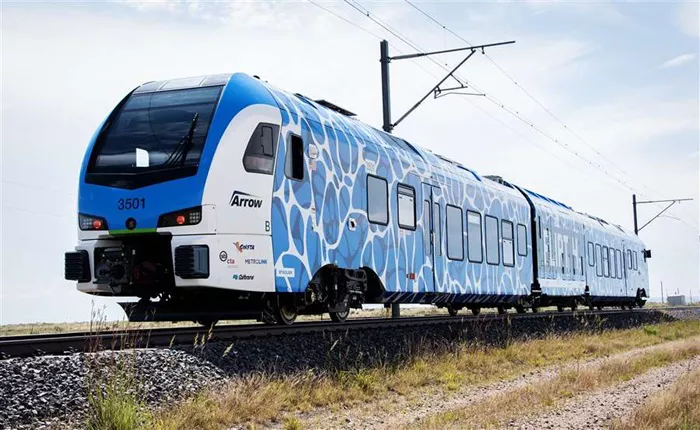The San Bernardino County Transportation Authority (SBCTA) has announced the arrival of North America’s first zero-emission, hydrogen fuel cell-powered passenger train at the San Bernardino Depot. This groundbreaking train, known as a Zero Emission Multiple Unit (ZEMU), adheres to Federal Railroad Administration (FRA) standards and operates with only water vapor as its emission.
The ZEMU is slated to run between San Bernardino and Redlands, covering approximately 22 miles as part of Metrolink’s Arrow Corridor. The project culminates over a decade of planning and four years of development, aiming to provide a sustainable alternative for one of the nation’s most heavily trafficked and polluted areas.
“ZEMU’s arrival in San Bernardino is a significant milestone recognizing years of strategic planning for a greener rail system and a commitment to innovative transportation solutions in San Bernardino County,” said SBCTA President Ray Marquez.
The hydrogen-powered train, manufactured by Swiss company Stadler, is branded as the Fast Light Intercity and Regional Train (FLIRT) H2. Funded in part by federal grants received in 2016, the project supports infrastructure improvements along the Arrow Corridor.
The FLIRT H2 model is designed to replace diesel trains on lines that lack full electrification. With a lightweight aluminum frame, the train’s two-car setup houses its hydrogen fuel tank and battery system centrally between them. It has a maximum range of 286 miles and can reach speeds of up to 79 mph, with a refueling time of under 30 minutes.
Earlier this year, Stadler’s FLIRT H2 set a world record for the longest distance traveled by a fuel cell electric train without refueling, covering 1,741.7 miles over 46 hours. This achievement, recorded by Guinness World Records, adds to Stadler’s previous record for the longest journey by a battery-powered train.
In the coming weeks, the ZEMU will begin test runs along the Arrow Corridor, with plans to fully integrate it into Metrolink service by 2025, solidifying California’s commitment to zero-emission transit solutions.
Related topics:
- Republic Services Orders 100 More McNeilus Electric Refuse Trucks to Expand Eco-Friendly Fleet
- Growing Concerns Over AdBlue in Heavy Transport and Lifting Sectors
- Cummins Launches Eclipse CANought: A Game-Changer in Open Telematics

